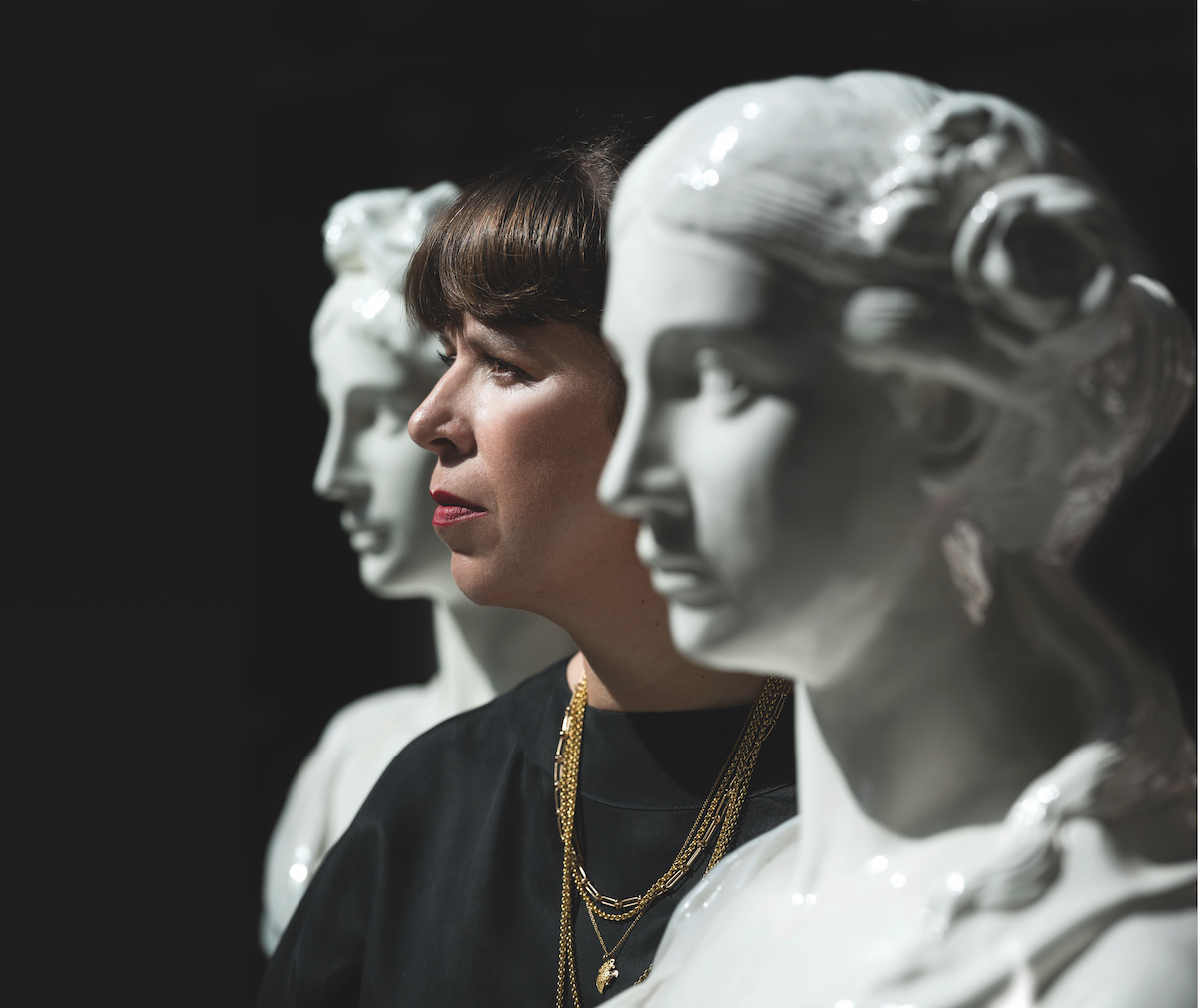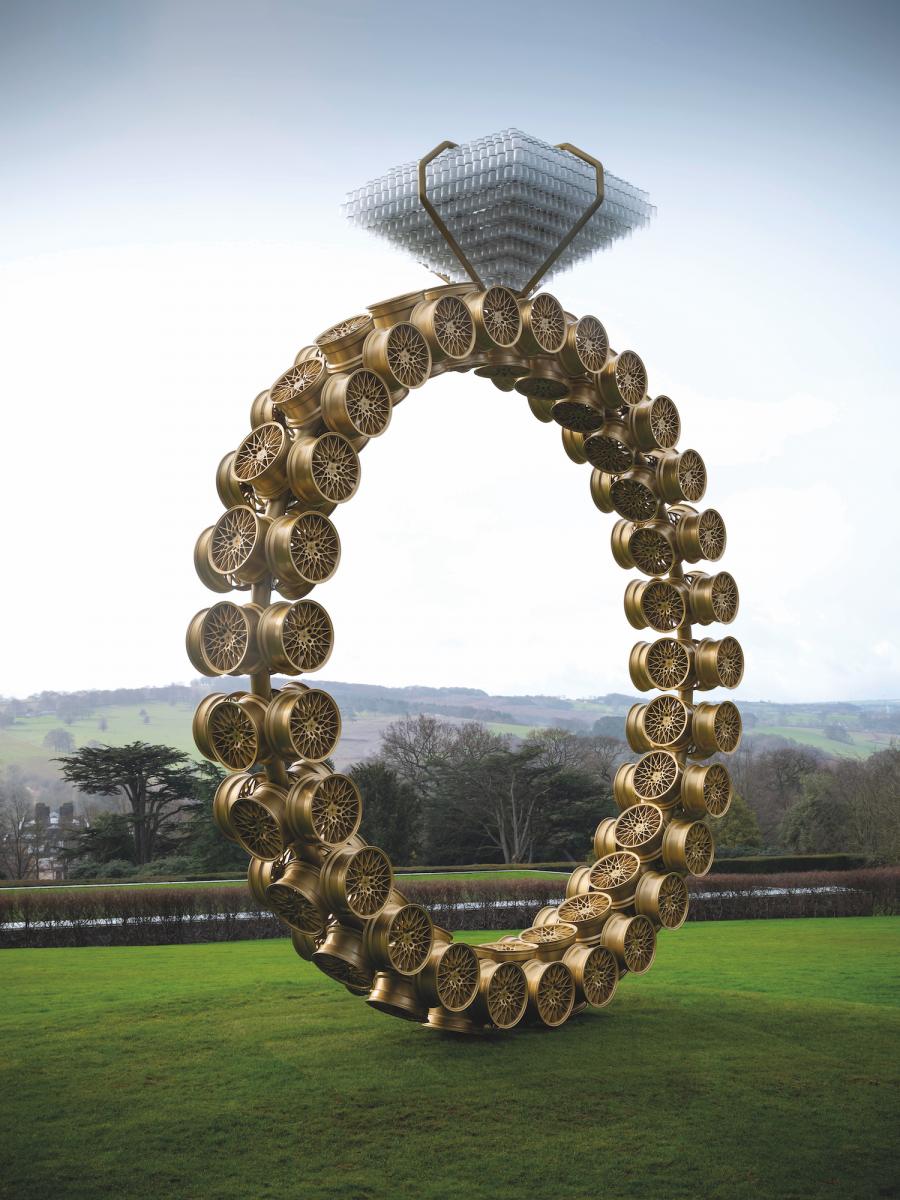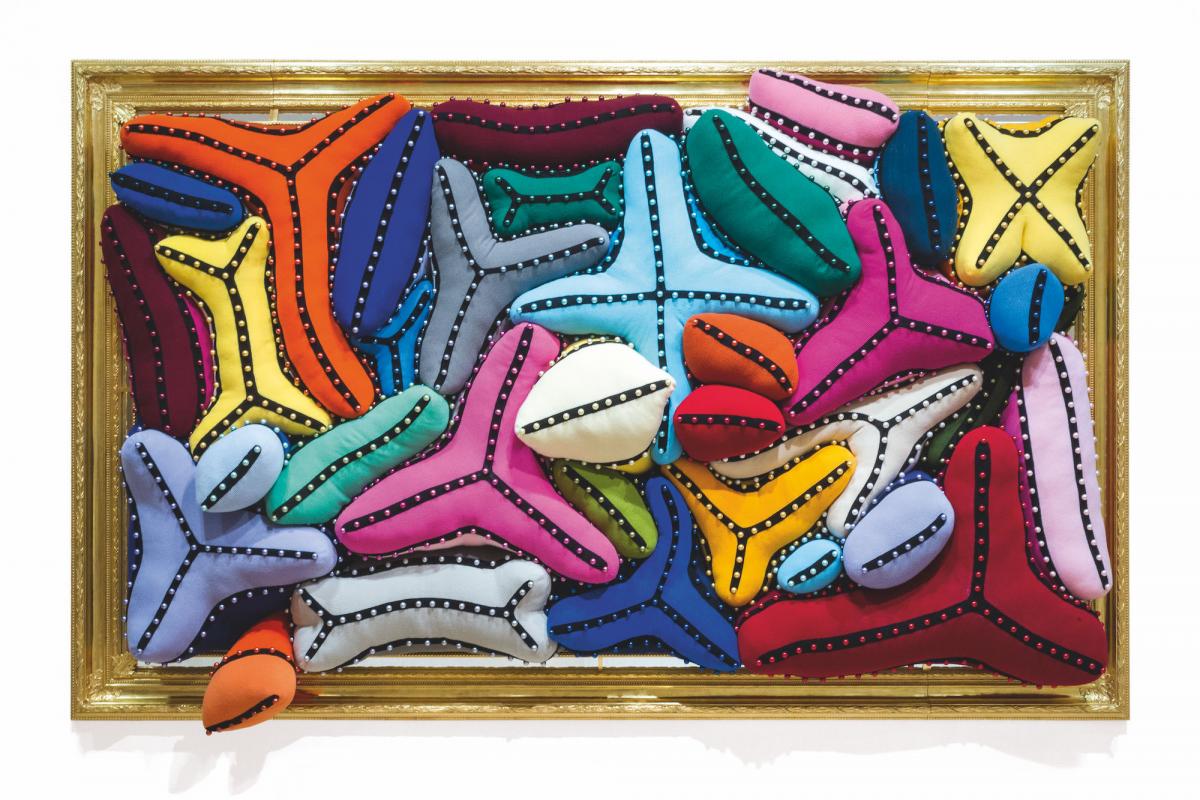This wonderful Cornish workshop and museum is dedicated to the legacy of studio pottery trailblazer Bernard Leach
On Another Scale: Joana Vasconcelos
On Another Scale: Joana Vasconcelos
20 Dec 2021
With her exhibition in Yorkshire, the artist toys with our perceptions of the everyday, in a supersized way. Hers is subversive art, with potent messages, as Holly Black discovers

Portrait of Joana Vasconcelos. © Kenton Thatcher
In the work of Joana Vasconcelos, nothing is quite as it seems. The Portuguese artist creates gargantuan installations that often take the form of recognisable objects, but it is her use of materials and subversive symbolism that encourage us to look again. A pair of glamorous high heels crafted from kitchen pots and pans; a Venetian mask formed from elaborate Baroque mirrors; even a chandelier made of tampons – all of these works resonate on an aesthetic level and cause one to marvel at their construction. Once she draws you in, more complex, conceptual concerns of gender, sexuality and cultural identity come to the fore, revealing themselves through her uncanny assemblages.
Vasconcelos is not the first artist to challenge the innate symbolism of everyday objects. The Surrealists loved to lean into the absurd (consider Dalí’s Lobster Telephone or Méret Oppenheim’s Breakfast in Fur), and feminist critiques have often interrogated the domestic space. However, her fusion of joyful motifs and epic proportions give cause to marvel. She is a master of spectacle, and loves to involve her audience, whatever their background.

Vasconcelos’ swimming pool in Edinburgh, Gateway. Image By Allan Pollok-Morris, Courtesy Jupiter Artland
‘It’s important to have universal symbols so that you can communicate with different cultures,’ she explains, when we speak via Zoom. ‘You enter through something you do know, to discover something you don’t.’ She is at home in Lisbon, where the need to shut down her 50-person strong atelier due to the pandemic has not hampered her creativity. Throughout our conversation she draws beautiful looping patterns in a range of colours, reminiscent of her whimsical swimming pool Gateway, which was installed at Jupiter Artland, just outside Edinburgh, in 2019. It is formed from 11,366 hand-painted tiles produced in a traditional Portuguese factory. When seen from above, the pool calls to mind a fantastical cartoon- style paint splat; it also has celestial connotations relating to the artist’s own astrological chart.
CRAFT AND COLLABORATION
Although Vasconcelos has a great deference for craftsmanship, she makes it clear that she is driven by the idea, not the material. ‘I am a conceptual artist. I’m not like the sculptors of the 19th century. I have a team of craftspeople with incredible knowledge and skills, from wood and metal to knitting and embroidery. They enable me to do my work. Sometimes I get these crazy ideas, and instead of searching for someone to make them a reality, I have those people right here. It’s dynamic and empowering. There is no constant questioning of what is possible. It allows me to get crazier and crazier.’
These outlandish notions often come when she is invited to participate in a particular project. In 2012, for instance, she became the first female and youngest artist to exhibit within the Palace of Versailles. Instead of attempting to fit in with the opulent surroundings, she challenged them by centring ideas of women’s experience. While crochet- covered objects, a feathered helicopter, and a Heart of Viana (the Portuguese emblem for love) formed from red plastic cutlery were permitted, her chandelier was not, on the grounds that a sculpture made from menstrual products was ‘too sexual’.
The Bride, an imposing chandelier, made from tampons. Courtesy the artist
More recently, Vasconcelos has mounted her exhibition at Yorkshire Sculpture Park (open until January 2022), spanning both interior galleries and the landscape beyond. The exhibition is, says the park, ‘a celebration of the artist’s unbridled imagination’. Within, visitors can expect her multicoloured crochet, 12-metre long Valkyrie Marina Rinaldi (2014), with its tentacle limbs, from her series Valkyries, based on those warrior women of Norse mythology. And without, they can catch works such as her Solitário [Solitaire] (2018).
This seven-metre-high ring is made of car wheel trims, topped with a ‘diamond’ of whisky glasses. Representing society’s ambitions to acquire wealth, it also speaks of symbols of luxury, such as the diamond solitaire, that bridge social classes. It was a proud moment for the artist, who had long considered the park to be a space of artistic renown. ‘I started to get a bit fed up because friends and colleagues would say, “you’ve done Versailles, but have you done YSP yet?”,’ she laughs. ‘It took me a few years, but I’m finally here, and it is a pleasure to show work in such beautiful surroundings. You can see art with mud on your boots. What more could you ask for?’

Solitaire, on show now in Yorkshire. © Jonty Wilde
IDEAS AND OPPORTUNITY
For her next major installation, Vasconcelos will take the idea of audience experience even further, by building a massive four-storey, 12-metre- high wedding cake in the grounds of Waddesdon Manor. The self-described ‘impossible project’, which she has been working on since 2017, will push the boundaries of art, architecture and a sense of shared celebration. Ceramic on the outside and textile within, it will, says the artist, ‘exist between reality
and a magical world, where people can be part of the artwork by entering the cake and becoming one of the two figurines on top. I hope visitors will be able to get married there. That way, people will forge memories that last a lifetime.’
Such an elaborate undertaking was inspired by the manor and the legacy that the Rothschilds have built there: ‘Some projects need to find the right partner. If you have the concept, but not the right location or person to make it for, it doesn’t make any sense.’
‘I want people to be able to follow their dreams, whether it is through art, dance or music’
While Vasconcelos has certainly embraced illustrious sites in which to exhibit her work, she takes the social responsibilities of being an acclaimed artist seriously: ‘In troubled times, artists have a crucial role. We are a voice that can be heard,’ she has said. For her, that role involves her eponymous foundation, which supports young people in pursuing careers in the arts, through a range of scholarships and bursaries.
‘I want people to be able to follow their dreams, whether it is through art, dance or music,’ she says. The foundation invests in individuals who need recognition and emotional support as much as financial provisions to flourish. ‘I am very proud of how we helped a local girl recently,’ Vasconcelos recalls. ‘She was not from a wealthy background, and her mother was ill. She wanted to study scenography in London but felt she had to stay at home to care for her mother and mind her shop. Instead, we said we would pay for her tuition. She was very brave, finished her studies, and has returned to a job in a reputable theatre in Portugal. Now she has the means to care for her family.’

The artist’s handmade woollen crochet work, Finisterra. Courtesy the artist
Vasconcelos’ studio also works with institutions to employ people with mental health issues, refugees and others who might otherwise find work hard to come by. They work with other craftspeople to crochet and embroider, contributing to elaborate ongoing sculptural series such as Vasconcelos’ Valkyries. For Vasconcelos, offering these kinds of creative, paid opportunities, is a given. ‘I do my share, and if the art world thinks I’m good enough, I will be able to support my studio and provide for my family, and that way I can help others to pursue their dreams. That is what I truly believe in.’
I ask her if the benefits of creative output across all areas of society have been ignored by governments and educational systems for too long. She agrees, yet, unsurprisingly, distils the concept even further: ‘If there were more artists in the world, it would be a better place.’
SEE
Joana Vasconcelos: Beyond at Yorkshire Sculpture Park, West Bretton, Yorkshire;
Until 9 January 2022
ysp.org.uk
This interview first appeared in the winter 2021 issue of The Arts Society Magazine, available exclusively to Members and Supporters
About the Author
Holly Black
Holly Black is The Arts Society's Digital Editor
JOIN OUR MAILING LIST
Become an instant expert!
Find out more about the arts by becoming a Supporter of The Arts Society.
For just £20 a year you will receive invitations to exclusive member events and courses, special offers and concessions, our regular newsletter and our beautiful arts magazine, full of news, views, events and artist profiles.
FIND YOUR NEAREST SOCIETY
MORE FEATURES
Ever wanted to write a crime novel? As Britain’s annual crime writing festival opens, we uncover some top leads
It’s just 10 days until the Summer Olympic Games open in Paris. To mark the moment, Simon Inglis reveals how art and design play a key part in this, the world’s most spectacular multi-sport competition



